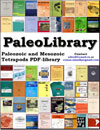
Complete Data Base of Paleozoic and Mesozoic Tetrapods.
Paleo-News and illustrations. Big electronic PDF-library.
| |
| PaleoNews |
| Classification |
| Books and Articles |
| Contact |
| Forum |
сайт о динозаврах
рейтинг сайтов
Free Counter
myspace hit counter
The evolutionary and morphological history of the parasphenoid bone in vertebrates. |
June 30 , 2016 The parasphenoid is located in the cranium of many vertebrates. When present, it is always an unpaired, dermal bone. While most basal vertebrates have a parasphenoid, most placental mammals lack this element and have an unpaired, dermal vomer in a similar position (i.e. associated with the same bones) and with a similar function. As such, the parasphenoid and the vomer were considered homologous by some early twentieth century researchers. However, others questioned this homology based on comparisons between mammals and reptiles. Here we investigate the parasphenoid bone across the major vertebrate lineages (amphibians, reptiles, mammals and teleosts) including both developmental and evolutionary aspects, which until now have not been considered together. We find that within all the major vertebrate lineages there are organisms that possess a parasphenoid and a vomer, while the parasphenoid is absent within caecilians and most placental mammals. Based on our assessment and Patterson's conjunction tests, we conclude that the non-mammalian parasphenoid and the vomer in mammals cannot be considered homologous. Additionally, the parasphenoid is likely homologous between sarcopterygian and actinopterygian lineages. This research attempts to resolve the issue of the parasphenoid homology and highlights where gaps in our knowledge are still present. Jade B. Atkins and Tamara A. Franz-Odendaal (2016)
|
